-
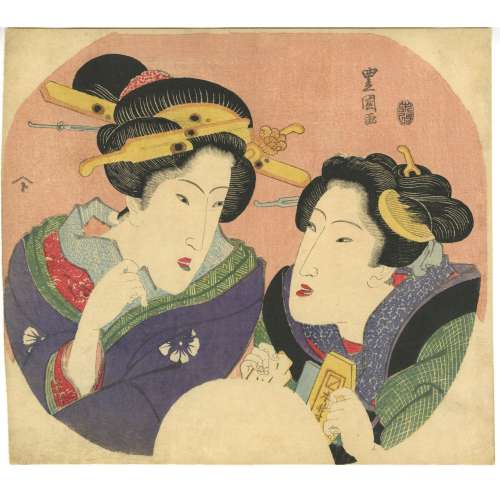 Artist: Utagawa Toyokuni I [歌川豊国] (1769–1825). Pubisher: Enshūya Matabei (遠州屋又兵衛) (c. 1768 – 1881), seal name: Enmata [ 遠又]. Signed: Toyokuni ga [豊国画]. Date-aratame censor seal: 未改, Bunsei 6 (1823). Size: uchiwa-e; 233 x 262 mm. Ref: Israel Goldman. Japanese Prints, Paintings and Books / Catalogue 28, 2022: № 14.
Artist: Utagawa Toyokuni I [歌川豊国] (1769–1825). Pubisher: Enshūya Matabei (遠州屋又兵衛) (c. 1768 – 1881), seal name: Enmata [ 遠又]. Signed: Toyokuni ga [豊国画]. Date-aratame censor seal: 未改, Bunsei 6 (1823). Size: uchiwa-e; 233 x 262 mm. Ref: Israel Goldman. Japanese Prints, Paintings and Books / Catalogue 28, 2022: № 14. -
 Title: Modori Kago [戻駕] (Returning palanquin). The dance-drama Modori Kago Iro ni Aikata [戻駕色相肩] premiered in the 11th lunar month of 1788 at the Nakamuraza [中村座], within Sakurada Jisuke I's kaomise [顔見世] (faceshowing) program Tôzumô Hana no Edogata [唐相撲花江戸方]", which celebrated the homecoming to Edo, after two years' absence, of Nakamura Nakazō I, and was intended to show off his particular talents in the role of Jirosaku (in reality Ishikawa Goemon [石川 五右衛門]) [kabuki21]. The symbol on a green book cover is the informal crest of tokiwazu-bushi [常磐津節] shaped like a water chestnut (Eleocharis dulcis) lozenge. Artist signature 国盛画 (Kunimori ga) with red toshidama. According to Samuel L. Leiter’s Kabuki Encyclopedia (1979), p. 243: The palanquin bearers Nanpa no Jirosaku and Azuma no Yōshirō, who are bearing a palanquin with a courtesan's young handmaiden in it, stop to rest at Kyoto's Murasakino, and each dances his regional dance. Then they call the girl, who does a dance showing the visitors to the famous pleasure quarters, Yoshiwara and Shimabara. The two men recognize each other as Ishikawa Goemon and Masashiba Hisayoshi, sworn enemies, and engage in a fight. This number is the only remaining section of an annual "faceshowing” (kaomize) work with a plot based on the medieval chronicle called the Toikōki. The full-length piece was called Kara Sumō Hanaeda no Kata. It is one of the most famous tokiwazu pieces and preserves the old-style Kabuki flavour. Nakamura Nakazō I played Jirosaku and Matsumoto Kōshirō IV was Yoshiro in the first production. The handmaiden was Matsumoto Komesaburō (probably Matsumoto Komasaburō I, an unknown actor [SV]). According to Egenolf Gallery: This work was first performed in 1788 at the Edo Nakamura-za as the season’s first performance and featured Nakamura Nakazō, who returned to Edo after three years in Osaka. It was a dance with tokiwazu chanting and was designed for him to play the lead role. In the piece, two palanquin carriers, one from Osaka, another from Edo, and a passenger – a kamuro, (a young geisha-in-training) exchange stories about the pleasure quarters of Shimabara and Yoshiwara. The text of the chanting book is open next to her, carrying the title “Collection of Practicing” [稽古尽くし], on which the green bundle cover carries the crest of Tokiwazu School, matsu-kawa-bishi, diamond variety of pine bark and the artist’s signature. Tokiwazu is a type of jōruri, narrative music, and accompanies dancing on the kabuki stage. Ref.: Christie's 27 Mar 2006. Publisher: Maruya Jinpachi, seal Marujin (Marks: 12-029 | 294e) Single nanushi censor seal: Mura (Murata Sahei, 1842-46). Provenance: Circular seal of the collector Huguette Bérès to verso. Contributors: Utagawa Kunimori [歌川国盛] (Japanese, fl. c. 1818 – 1943) – artist. Maruya Jinpachi [丸屋甚八] (Japanese, fl. 1770 – 1842) – publisher. Other mentioned: Nakamura Nakazō I [中村仲蔵] (Japanese, 1736 – 1790); other names: Nakayama Kojūrō VI, Nakamura Ichijūrō, Nakayama Manzō – actor. Matsumoto Kōshirō IV [松本幸四郎] (Japanese, 1737 – 1802); other names: Omegawa Kyōjūrō; Ichikawa Komazō II, Ichikawa Somegorô I, Ichikawa Takejūrō ; Segawa Kinji; Segawa Kingo – actor. Sakurada Jisuke I [桜田治助] (Japanese, 1734 – 1806) – dramatist.
Title: Modori Kago [戻駕] (Returning palanquin). The dance-drama Modori Kago Iro ni Aikata [戻駕色相肩] premiered in the 11th lunar month of 1788 at the Nakamuraza [中村座], within Sakurada Jisuke I's kaomise [顔見世] (faceshowing) program Tôzumô Hana no Edogata [唐相撲花江戸方]", which celebrated the homecoming to Edo, after two years' absence, of Nakamura Nakazō I, and was intended to show off his particular talents in the role of Jirosaku (in reality Ishikawa Goemon [石川 五右衛門]) [kabuki21]. The symbol on a green book cover is the informal crest of tokiwazu-bushi [常磐津節] shaped like a water chestnut (Eleocharis dulcis) lozenge. Artist signature 国盛画 (Kunimori ga) with red toshidama. According to Samuel L. Leiter’s Kabuki Encyclopedia (1979), p. 243: The palanquin bearers Nanpa no Jirosaku and Azuma no Yōshirō, who are bearing a palanquin with a courtesan's young handmaiden in it, stop to rest at Kyoto's Murasakino, and each dances his regional dance. Then they call the girl, who does a dance showing the visitors to the famous pleasure quarters, Yoshiwara and Shimabara. The two men recognize each other as Ishikawa Goemon and Masashiba Hisayoshi, sworn enemies, and engage in a fight. This number is the only remaining section of an annual "faceshowing” (kaomize) work with a plot based on the medieval chronicle called the Toikōki. The full-length piece was called Kara Sumō Hanaeda no Kata. It is one of the most famous tokiwazu pieces and preserves the old-style Kabuki flavour. Nakamura Nakazō I played Jirosaku and Matsumoto Kōshirō IV was Yoshiro in the first production. The handmaiden was Matsumoto Komesaburō (probably Matsumoto Komasaburō I, an unknown actor [SV]). According to Egenolf Gallery: This work was first performed in 1788 at the Edo Nakamura-za as the season’s first performance and featured Nakamura Nakazō, who returned to Edo after three years in Osaka. It was a dance with tokiwazu chanting and was designed for him to play the lead role. In the piece, two palanquin carriers, one from Osaka, another from Edo, and a passenger – a kamuro, (a young geisha-in-training) exchange stories about the pleasure quarters of Shimabara and Yoshiwara. The text of the chanting book is open next to her, carrying the title “Collection of Practicing” [稽古尽くし], on which the green bundle cover carries the crest of Tokiwazu School, matsu-kawa-bishi, diamond variety of pine bark and the artist’s signature. Tokiwazu is a type of jōruri, narrative music, and accompanies dancing on the kabuki stage. Ref.: Christie's 27 Mar 2006. Publisher: Maruya Jinpachi, seal Marujin (Marks: 12-029 | 294e) Single nanushi censor seal: Mura (Murata Sahei, 1842-46). Provenance: Circular seal of the collector Huguette Bérès to verso. Contributors: Utagawa Kunimori [歌川国盛] (Japanese, fl. c. 1818 – 1943) – artist. Maruya Jinpachi [丸屋甚八] (Japanese, fl. 1770 – 1842) – publisher. Other mentioned: Nakamura Nakazō I [中村仲蔵] (Japanese, 1736 – 1790); other names: Nakayama Kojūrō VI, Nakamura Ichijūrō, Nakayama Manzō – actor. Matsumoto Kōshirō IV [松本幸四郎] (Japanese, 1737 – 1802); other names: Omegawa Kyōjūrō; Ichikawa Komazō II, Ichikawa Somegorô I, Ichikawa Takejūrō ; Segawa Kinji; Segawa Kingo – actor. Sakurada Jisuke I [桜田治助] (Japanese, 1734 – 1806) – dramatist. -
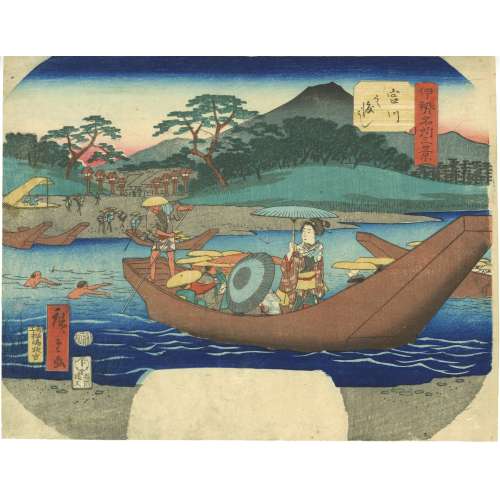 Artist: Utagawa Hiroshige II (二代目 歌川広重] (Japanese, 1826 – 1869). Signed: Hiroshige ga. Publisher: Enshūya Matabei [遠州屋又兵衛] (Japanese, fl. c. 1768 – 1881); (Enmata [遠又]), seal 22-009 (Marks). Block carver: Matsushima Masakichi (Japanese, fl. c. 1847-65); seal: [松嶋彫政] – Hori Masa (Frieze, 2009: 142). Combined date seal and kiwame censor seal: Bunkyū 2 (1862). Media: Fan print (uchiwa-e, 団扇絵), 230 x 298 mm Series: Three Famous Views in Ise [伊勢名所三景] (Ise meisho sankei).
Artist: Utagawa Hiroshige II (二代目 歌川広重] (Japanese, 1826 – 1869). Signed: Hiroshige ga. Publisher: Enshūya Matabei [遠州屋又兵衛] (Japanese, fl. c. 1768 – 1881); (Enmata [遠又]), seal 22-009 (Marks). Block carver: Matsushima Masakichi (Japanese, fl. c. 1847-65); seal: [松嶋彫政] – Hori Masa (Frieze, 2009: 142). Combined date seal and kiwame censor seal: Bunkyū 2 (1862). Media: Fan print (uchiwa-e, 団扇絵), 230 x 298 mm Series: Three Famous Views in Ise [伊勢名所三景] (Ise meisho sankei). -
 The so-called Yoshirō-tsuba [与四郎鐔] with an iron plate of mokkō form densely decorated with floral arabesque and adorned with eight pierced, chiselled and inlaid brass roundels and signed on both sides 'Koike Yoshirō Izumi no Kami Naomasa'. Four of the roundels are pierced and have geometrical designs representing flowers (e.g. wood sorrel) or snowflakes. Four others are solid and represent family crests; on one side: Mulberry (kaji) – mon of the Matsunaga clan [松永氏], Bamboo Grass (sasa) – mon of the Takenaka clan [竹中氏]), Wild Geese (kari) – mon of the Shibata clan [新発田氏]), and Pine Needles (matsuba); on the other side: Nine Stars (kuyō) – the Hosokawa clan [細川氏], Paulownia (kiri) – the Toyotomi clan [豊臣氏]), Bamboo Leaves (take) – the Minamoto clan [源], and Seven Treasures (shippo) – Izumo Genji clan [出雲源氏]. Hitsu-ana obliterated with a nanako-treated pewter plug. Brass with rainbow patina. Artist: Koike Izumi no Kami Naomasa (Japanese, active late 16th – early 17th century). The Momoyama or early Edo period, end of the 16th to the first half of the 17th century (1574-1650). Size: 81.7 x 78.8 x 4.3 cm. Provenance: Dr. Kazutaro Torigoye. Special thanks to Markus Sesko for providing the translation of hakogaki. Hakokaki lid (outside): 小池与四郎 – Koike Yoshirō Hakokaki lid (inside): 銘曰小池与四郎 – Mei’etsu: Koike Yoshirō – Signed: Koike Yoshirō 和泉守直正 – Izumi no Kami Naomasa – Izumi no Kami Naomasa 木瓜形 鉄地 – Mokkōgata, tetsu-ji – Lobed shape, of iron 真鍮据紋象嵌 – Shinchū suemon-zōgan – with brass suemon-zōgan inlay 縦二寸七分横二寸六分 – Tate ni-sun shichi-bu, yoko ni-sun roku-bu – Height 8.2 cm, width 7.9 cm 右正真也 – Migi shōshin nari – Above described object is authentic 昭和廾九年八月十一日 – Shōwa nijūkyūnen hachigatsu jūichinichi – August 11, 1954 草堂「花押」– Sōdō + kaō – Sōdō [pen name of Torigoye Kazutarō, 鳥越一太郎] + monogram Ref.: (1) Tsuba Geijutsu-Ko by Kazutaro Torigoye, 1960; (2) Tsuba. An aesthetic study. By Kazutaro Torigoye and Robert E. Haynes from the Tsuba Geijutsu-kō of Kazataro Torigoye. Edited and published by Alan L. Harvie for the Nothern California Japanese Sword Club, 1994-1997, p. Yoshirō, 4. See also Yoshirō tsuba.
The so-called Yoshirō-tsuba [与四郎鐔] with an iron plate of mokkō form densely decorated with floral arabesque and adorned with eight pierced, chiselled and inlaid brass roundels and signed on both sides 'Koike Yoshirō Izumi no Kami Naomasa'. Four of the roundels are pierced and have geometrical designs representing flowers (e.g. wood sorrel) or snowflakes. Four others are solid and represent family crests; on one side: Mulberry (kaji) – mon of the Matsunaga clan [松永氏], Bamboo Grass (sasa) – mon of the Takenaka clan [竹中氏]), Wild Geese (kari) – mon of the Shibata clan [新発田氏]), and Pine Needles (matsuba); on the other side: Nine Stars (kuyō) – the Hosokawa clan [細川氏], Paulownia (kiri) – the Toyotomi clan [豊臣氏]), Bamboo Leaves (take) – the Minamoto clan [源], and Seven Treasures (shippo) – Izumo Genji clan [出雲源氏]. Hitsu-ana obliterated with a nanako-treated pewter plug. Brass with rainbow patina. Artist: Koike Izumi no Kami Naomasa (Japanese, active late 16th – early 17th century). The Momoyama or early Edo period, end of the 16th to the first half of the 17th century (1574-1650). Size: 81.7 x 78.8 x 4.3 cm. Provenance: Dr. Kazutaro Torigoye. Special thanks to Markus Sesko for providing the translation of hakogaki. Hakokaki lid (outside): 小池与四郎 – Koike Yoshirō Hakokaki lid (inside): 銘曰小池与四郎 – Mei’etsu: Koike Yoshirō – Signed: Koike Yoshirō 和泉守直正 – Izumi no Kami Naomasa – Izumi no Kami Naomasa 木瓜形 鉄地 – Mokkōgata, tetsu-ji – Lobed shape, of iron 真鍮据紋象嵌 – Shinchū suemon-zōgan – with brass suemon-zōgan inlay 縦二寸七分横二寸六分 – Tate ni-sun shichi-bu, yoko ni-sun roku-bu – Height 8.2 cm, width 7.9 cm 右正真也 – Migi shōshin nari – Above described object is authentic 昭和廾九年八月十一日 – Shōwa nijūkyūnen hachigatsu jūichinichi – August 11, 1954 草堂「花押」– Sōdō + kaō – Sōdō [pen name of Torigoye Kazutarō, 鳥越一太郎] + monogram Ref.: (1) Tsuba Geijutsu-Ko by Kazutaro Torigoye, 1960; (2) Tsuba. An aesthetic study. By Kazutaro Torigoye and Robert E. Haynes from the Tsuba Geijutsu-kō of Kazataro Torigoye. Edited and published by Alan L. Harvie for the Nothern California Japanese Sword Club, 1994-1997, p. Yoshirō, 4. See also Yoshirō tsuba. -
 Artist: Utagawa Kunisada [歌川 国貞] a.k.a. Utagawa Toyokuni III [三代歌川豊国] (Japanese, 1786 – 1865). Artist signature: By the brush of the 79-year-old Toyokuni [七十九歳豊國画] (Nanajūkyū-sai Toyokuni ga). Publisher: Ebiya Rinnosuke [海老屋林之助] (Japanese, fl. c. 1832 – 1895); seal: ト/ 海老林 (to, Ebirin). Block carver: Matsushima Masakichi [松島政吉]; seal: carved by Masa [彫政] (Hori Masa). Combined date seal and kiwame censor seal: [子極] 1864 (Bunkyū 4/Genji 1). Media: Untrimmed fan print (uchiwa-e), 223 x 297 mm. Inscription in the cartouches: (R) Wakana-hime [若菜姫], Sawamura Tanosuke III [沢村田之助]; (L) Ashikaga Sanshichirō [足利三七郎], Sawamura Tosshō II [沢村訥升]. Play: Kinoene Soga Daikoku-bashira [甲子曽我大国柱], performed at the Morita theatre [森田座・守田座] (Morita-za) in 1864 (Bunkyū 4/Genji 1), 2nd month (see playbill at MFA-Boston Collection). Playwright: Muraoka Kōji II [村岡幸治]. Actors and Characters: Sawamura Tanosuke III [三代目沢村田之助] (Japanese, 1859 – 1878); other names: Shozan [曙山] (poetry name), Sawamura Yoshijirō I [初代沢村由次郎], here in the role of Princess Wakana [若菜姫] (Wakana-hime) (R). The story about Princess Wakana, Shiranui Monogatari, was written by Ryukatei Tanekazu [柳下亭種員] (Japanese, 1807 – 1858) and published as a 90-volume book of comics between 1849 and 1855. ...The tale revolves around the clash between the Kikuchi and Ōtomo clans. Princess Wakana’s father Ōtomo Sōrin [大友 宗麟] (1530 – 1587) was killed in a battle, and his spirit demanded revenge. To appease her late father's spirit, Princes Wakana acquired the power of the Earth Spider. She often appears in prints with a magic scroll, which helps her fight various enemies. Sawamura Tosshō II [二代目沢村訥升] (Japanese, 1854 – 1879); other names: Kōga [高賀] (poetry name), Sawamura Genpei II [二代目沢村源平], Sawamura Sōjūrō [澤村宗十郎], Suketakaya Takasuke IV [四代目助高屋高助], Sawamura Tosshi VI [六代目澤村訥子] (poetry name), here in the role of Ashikaga Sanshichirō [足利三七郎] (L) with a horse. According to Markus Sesko, the scene comes from the kabuki play Umakiri (馬斬り) by Tatsuoka Mansaku [辰岡万作] (17432 – 1809), which premiered in 1794. It was later assimilated into the Kabuki play Kozotte Mimasu Kuruwa no Datezome [襷廓三升伊達染], which was staged in the 1st lunar month of 1853 at the Nakamura-za. Umakiri is based on a Kyōgen play featured in Hideyoshi’s biography Taikōki [太閤記]. Its plot is that Ashikaga Sanchichirō Yoshitaka [足利三七郎義孝・義高], who is supposed to allude to Nobunaga’s son Oda Sanshichirō Nobutaka [織田三七郎信孝], attacks and kills a horse that is carrying 3,000 ryō (金三千両), money Mashiba Hisayoshi [真柴久吉] (an allusion to Hashiba Hideyoshi [羽柴秀吉]) had sent to be donated to a shrine on Mt. Kōya. The surrounding people try to catch him, but when they hear it is Yoshitaka who killed the horse, they fall to the ground and prostrate, and Yoshitaka leisurely leaves with the money. The plot is very simple, but Yoshitaka’s dashing appearance makes it very pleasing to watch. There are also prints that quote the main protagonist as Ashikaga Sanshichirō Harutaka [足利三七郎春高], and there is another title for the play, Sanzen-Ryō Kogane no Kurairi [三千両黄金蔵入] (Pocketing 3,000 ryō of gold). For reference, see also the BLOG. What these two characters are doing in one play remains a riddle. As Mr Graebner comments: "Most kabuki plays were only performed for one season (two months), and the books were lost. The playwrights have repeatedly used parts of plots from other plays, they have adopted characters, sometimes with the same or similar names. What can be found is the Kabuki Playbill (Tsuji banzuke) with cast and roles; the content is lost". Acknowledgements: Special thanks to Horst Graebner of the Kunisada Project and to Markus Sesko of The Metropolitan Museum, NY, for the analysis of the image and their invaluable contribution. For reference, see also:
Artist: Utagawa Kunisada [歌川 国貞] a.k.a. Utagawa Toyokuni III [三代歌川豊国] (Japanese, 1786 – 1865). Artist signature: By the brush of the 79-year-old Toyokuni [七十九歳豊國画] (Nanajūkyū-sai Toyokuni ga). Publisher: Ebiya Rinnosuke [海老屋林之助] (Japanese, fl. c. 1832 – 1895); seal: ト/ 海老林 (to, Ebirin). Block carver: Matsushima Masakichi [松島政吉]; seal: carved by Masa [彫政] (Hori Masa). Combined date seal and kiwame censor seal: [子極] 1864 (Bunkyū 4/Genji 1). Media: Untrimmed fan print (uchiwa-e), 223 x 297 mm. Inscription in the cartouches: (R) Wakana-hime [若菜姫], Sawamura Tanosuke III [沢村田之助]; (L) Ashikaga Sanshichirō [足利三七郎], Sawamura Tosshō II [沢村訥升]. Play: Kinoene Soga Daikoku-bashira [甲子曽我大国柱], performed at the Morita theatre [森田座・守田座] (Morita-za) in 1864 (Bunkyū 4/Genji 1), 2nd month (see playbill at MFA-Boston Collection). Playwright: Muraoka Kōji II [村岡幸治]. Actors and Characters: Sawamura Tanosuke III [三代目沢村田之助] (Japanese, 1859 – 1878); other names: Shozan [曙山] (poetry name), Sawamura Yoshijirō I [初代沢村由次郎], here in the role of Princess Wakana [若菜姫] (Wakana-hime) (R). The story about Princess Wakana, Shiranui Monogatari, was written by Ryukatei Tanekazu [柳下亭種員] (Japanese, 1807 – 1858) and published as a 90-volume book of comics between 1849 and 1855. ...The tale revolves around the clash between the Kikuchi and Ōtomo clans. Princess Wakana’s father Ōtomo Sōrin [大友 宗麟] (1530 – 1587) was killed in a battle, and his spirit demanded revenge. To appease her late father's spirit, Princes Wakana acquired the power of the Earth Spider. She often appears in prints with a magic scroll, which helps her fight various enemies. Sawamura Tosshō II [二代目沢村訥升] (Japanese, 1854 – 1879); other names: Kōga [高賀] (poetry name), Sawamura Genpei II [二代目沢村源平], Sawamura Sōjūrō [澤村宗十郎], Suketakaya Takasuke IV [四代目助高屋高助], Sawamura Tosshi VI [六代目澤村訥子] (poetry name), here in the role of Ashikaga Sanshichirō [足利三七郎] (L) with a horse. According to Markus Sesko, the scene comes from the kabuki play Umakiri (馬斬り) by Tatsuoka Mansaku [辰岡万作] (17432 – 1809), which premiered in 1794. It was later assimilated into the Kabuki play Kozotte Mimasu Kuruwa no Datezome [襷廓三升伊達染], which was staged in the 1st lunar month of 1853 at the Nakamura-za. Umakiri is based on a Kyōgen play featured in Hideyoshi’s biography Taikōki [太閤記]. Its plot is that Ashikaga Sanchichirō Yoshitaka [足利三七郎義孝・義高], who is supposed to allude to Nobunaga’s son Oda Sanshichirō Nobutaka [織田三七郎信孝], attacks and kills a horse that is carrying 3,000 ryō (金三千両), money Mashiba Hisayoshi [真柴久吉] (an allusion to Hashiba Hideyoshi [羽柴秀吉]) had sent to be donated to a shrine on Mt. Kōya. The surrounding people try to catch him, but when they hear it is Yoshitaka who killed the horse, they fall to the ground and prostrate, and Yoshitaka leisurely leaves with the money. The plot is very simple, but Yoshitaka’s dashing appearance makes it very pleasing to watch. There are also prints that quote the main protagonist as Ashikaga Sanshichirō Harutaka [足利三七郎春高], and there is another title for the play, Sanzen-Ryō Kogane no Kurairi [三千両黄金蔵入] (Pocketing 3,000 ryō of gold). For reference, see also the BLOG. What these two characters are doing in one play remains a riddle. As Mr Graebner comments: "Most kabuki plays were only performed for one season (two months), and the books were lost. The playwrights have repeatedly used parts of plots from other plays, they have adopted characters, sometimes with the same or similar names. What can be found is the Kabuki Playbill (Tsuji banzuke) with cast and roles; the content is lost". Acknowledgements: Special thanks to Horst Graebner of the Kunisada Project and to Markus Sesko of The Metropolitan Museum, NY, for the analysis of the image and their invaluable contribution. For reference, see also: -
 Artist: Utagawa Kunisada [歌川 国貞] a.k.a. Utagawa Toyokuni III [三代歌川豊国] (Japanese, 1786 – 1865). No publisher seal, no date or censor seal; probably a private printing. Signed: Kunisada ga [国貞画] in a red double gourd cartouche. Media: Untrimmed fan print (uchiwa-e), 231 x 294 mm, with the use of mica and black lacquer.
Artist: Utagawa Kunisada [歌川 国貞] a.k.a. Utagawa Toyokuni III [三代歌川豊国] (Japanese, 1786 – 1865). No publisher seal, no date or censor seal; probably a private printing. Signed: Kunisada ga [国貞画] in a red double gourd cartouche. Media: Untrimmed fan print (uchiwa-e), 231 x 294 mm, with the use of mica and black lacquer. -
 Artist: Utagawa Kunisada [歌川 国貞] a.k.a. Utagawa Toyokuni III [三代歌川豊国] (Japanese, 1786 – 1865). Pubisher (accorfding to Suzuki & Oka): Ibaya Senzaburō [伊場屋仙三郎] (Japanese, 1815 – 1869), Dansendō [伊場仙]. Title: Beauty holding a roll of paper (by seller); A woman of Edo (by Suzuki & Oka) Date seal and aratame censor seal: 1822 (Bunsei 5). Signed: Gototei Kunisada ga [五渡亭国貞画]. Media: Untrimmed fan print (uchiwa-e), 228 x 295 mm. Ref: [LIB-3085.2022] Jūzō Suzuki, Isaburō Oka. “The decadents”. — Tokyo: Kodansha International, 1969, p. 35, plate 30: exactly this print:
Artist: Utagawa Kunisada [歌川 国貞] a.k.a. Utagawa Toyokuni III [三代歌川豊国] (Japanese, 1786 – 1865). Pubisher (accorfding to Suzuki & Oka): Ibaya Senzaburō [伊場屋仙三郎] (Japanese, 1815 – 1869), Dansendō [伊場仙]. Title: Beauty holding a roll of paper (by seller); A woman of Edo (by Suzuki & Oka) Date seal and aratame censor seal: 1822 (Bunsei 5). Signed: Gototei Kunisada ga [五渡亭国貞画]. Media: Untrimmed fan print (uchiwa-e), 228 x 295 mm. Ref: [LIB-3085.2022] Jūzō Suzuki, Isaburō Oka. “The decadents”. — Tokyo: Kodansha International, 1969, p. 35, plate 30: exactly this print:
-
 Title: Early Spring [初春之図] (Hatsuharu no zu); Series: Fashionable Twelve Months [今様十二ヶ月] (Imayo juni-kagetsu). Another version of translation: Modern Beauties of Twelve Months. Artist: Utagawa Toyokuni I [歌川豊国] (1769–1825). Pubisher: Ibaya Senzaburō [伊場屋仙三郎] (Japanese, 1815 – 1869), seal: Dansendō [伊場仙]. Signed: Toyokuni ga [豊国画] and sealed with toshidama. Date-kiwame seal: Ushi (ox), Bunsei 5 (1822). Size: double-sheet uncut fan print ( aiban uchiwa-e), each 217 x 288 mm. Ref: Tokyo Museum Collection.
Title: Early Spring [初春之図] (Hatsuharu no zu); Series: Fashionable Twelve Months [今様十二ヶ月] (Imayo juni-kagetsu). Another version of translation: Modern Beauties of Twelve Months. Artist: Utagawa Toyokuni I [歌川豊国] (1769–1825). Pubisher: Ibaya Senzaburō [伊場屋仙三郎] (Japanese, 1815 – 1869), seal: Dansendō [伊場仙]. Signed: Toyokuni ga [豊国画] and sealed with toshidama. Date-kiwame seal: Ushi (ox), Bunsei 5 (1822). Size: double-sheet uncut fan print ( aiban uchiwa-e), each 217 x 288 mm. Ref: Tokyo Museum Collection.
Other five prints of this series: SVJP 0326.2020; SVJP-0362.2022; SVJP-0363.2022; SVJP-0364.2022; SVJP-0365.2022.

-
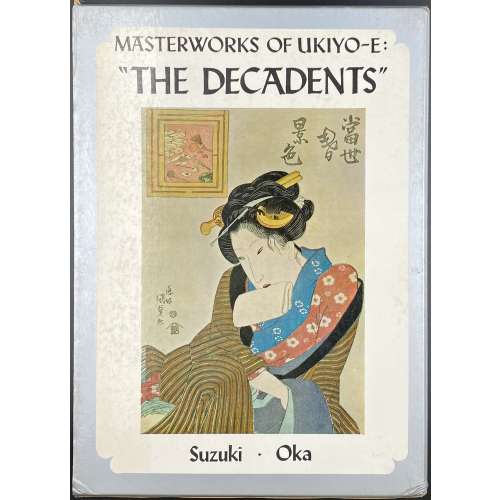 Description: Hardcover 26.5 x 19 cm, grey cloth, red lettering in kanji over black stripe to front, lettering to spine, tan endpapers, pictorial slipcase 27 x 19.5 cm; pp.: [1-6] 7-95 [96], pasted frontispiece and 79 colour illustrations with captions, within a collation. Series Masterworks of ukiyo-e, №8. ISBN: 9780870110986; 0870110985. Ref.: Worldcat Title-page (in frame): MASTERWORKS OF UKIYO-E | "THE DECADENTS” | by Jūzō Suzuki and Isaburō Oka | translation by John Bester | {publisher’s device} | KODANSHA INTERNATIONAL LTD. | Tokyo, Japan & Palo-Alto, Calif., U.S.A. || (Vertical text in kanji to the right, between rules). Artists: Utagawa Kunisada (Japanese [歌川 国貞], 1786 – 1865); Utagawa Kuniyoshi (Japanese [歌川 国芳], 1798 – 1861); Keisai Eisen [Japanese [渓斎 英泉], 1790 – 1848). Contributors: Jūzō Suzuki [鈴木重三] (Japanese, 1919 – 2010) – author. Isaburō Oka [岡畏三郎] (Japanese, 1914 –2010) – author. John Bester (British, 1927 – 2010) – translator Kunisada's fan print in this collection (exactly the same copy) [SVJP-0380.2022]:
Description: Hardcover 26.5 x 19 cm, grey cloth, red lettering in kanji over black stripe to front, lettering to spine, tan endpapers, pictorial slipcase 27 x 19.5 cm; pp.: [1-6] 7-95 [96], pasted frontispiece and 79 colour illustrations with captions, within a collation. Series Masterworks of ukiyo-e, №8. ISBN: 9780870110986; 0870110985. Ref.: Worldcat Title-page (in frame): MASTERWORKS OF UKIYO-E | "THE DECADENTS” | by Jūzō Suzuki and Isaburō Oka | translation by John Bester | {publisher’s device} | KODANSHA INTERNATIONAL LTD. | Tokyo, Japan & Palo-Alto, Calif., U.S.A. || (Vertical text in kanji to the right, between rules). Artists: Utagawa Kunisada (Japanese [歌川 国貞], 1786 – 1865); Utagawa Kuniyoshi (Japanese [歌川 国芳], 1798 – 1861); Keisai Eisen [Japanese [渓斎 英泉], 1790 – 1848). Contributors: Jūzō Suzuki [鈴木重三] (Japanese, 1919 – 2010) – author. Isaburō Oka [岡畏三郎] (Japanese, 1914 –2010) – author. John Bester (British, 1927 – 2010) – translator Kunisada's fan print in this collection (exactly the same copy) [SVJP-0380.2022]:

-
 An uncut fan print showing Otsu-e [大津絵] (Otsu pictures). Artist: Utagawa Sadahide [歌川貞秀] (Japanese, 1807 – 1879). Signed: Gountei Sadahide ga [五雲亭貞秀画] (Picture by Gountei Sadahide); characters on the Otsu-e. Publisher: Ibaya Senzaburō [伊場屋仙三郎] (Japanese, c. 1815 – 1869). Published: c. 1849. Inscription in a paper-weight shaped cartouche: [大津追 分絵の図] Ōtsu-oi wake-e no zu (Following Otsu – image of separate pictures) No date seal, no censor seal (privately printed?) Media: Fan print (uchiwa-e, 団扇絵), 235 x 298 mm.
An uncut fan print showing Otsu-e [大津絵] (Otsu pictures). Artist: Utagawa Sadahide [歌川貞秀] (Japanese, 1807 – 1879). Signed: Gountei Sadahide ga [五雲亭貞秀画] (Picture by Gountei Sadahide); characters on the Otsu-e. Publisher: Ibaya Senzaburō [伊場屋仙三郎] (Japanese, c. 1815 – 1869). Published: c. 1849. Inscription in a paper-weight shaped cartouche: [大津追 分絵の図] Ōtsu-oi wake-e no zu (Following Otsu – image of separate pictures) No date seal, no censor seal (privately printed?) Media: Fan print (uchiwa-e, 団扇絵), 235 x 298 mm. -
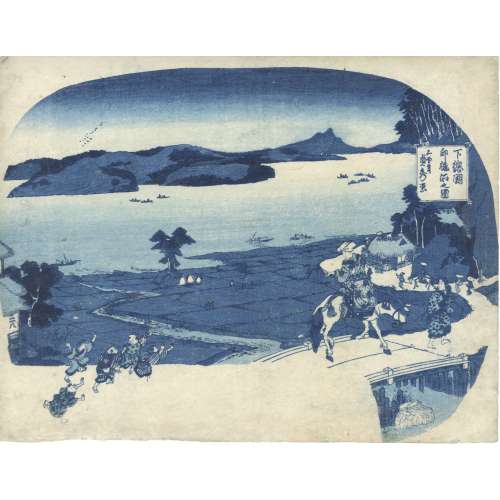 An uncut aizuri fan print showing travellers arriving at Inba Lake [印旛沼] (Inba-numa) on Shimosa Plateau [下総台地] (Shimōsa-daichi). Artist: Utagawa Sadahide [歌川貞秀] (Japanese, 1807 – 1879) Publisher: Unknown. Published: c. 1849. Signed: Gountei Sadahide ga [五雲亭 貞秀画] (Picture by Gountei Sadahide). Inscription in cartouche: Shimosa Plateau, Inbanuma (Inba Lake) [下總國印幡沼]. No date seal, no censor seal (privately printed?) Media: Fan print [団扇絵] (uchiwa-e), 235 x 300 mm.
An uncut aizuri fan print showing travellers arriving at Inba Lake [印旛沼] (Inba-numa) on Shimosa Plateau [下総台地] (Shimōsa-daichi). Artist: Utagawa Sadahide [歌川貞秀] (Japanese, 1807 – 1879) Publisher: Unknown. Published: c. 1849. Signed: Gountei Sadahide ga [五雲亭 貞秀画] (Picture by Gountei Sadahide). Inscription in cartouche: Shimosa Plateau, Inbanuma (Inba Lake) [下總國印幡沼]. No date seal, no censor seal (privately printed?) Media: Fan print [団扇絵] (uchiwa-e), 235 x 300 mm. -
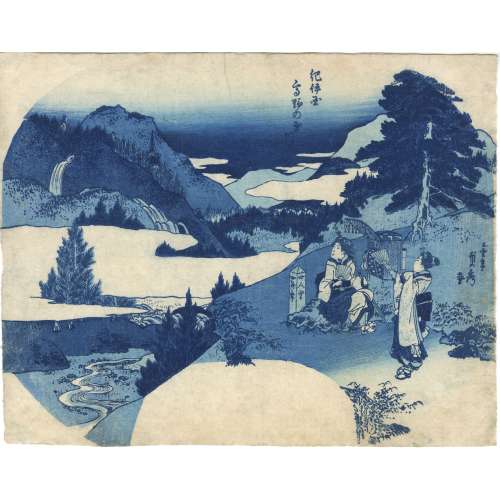 An uncut aizuri fan print showing two travellers admiring the view of the Tama River [多摩川] (Tamagawa) and Mount Kōya [高野山] (Kōyasan) in Kii Province [紀伊国] (Kii no Kuni). Artist: Utagawa Sadahide [歌川貞秀] (Japanese, 1807 – 1879). Signed: Gountei Sadahide ga [五雲亭貞秀画] (Picture by Gountei Sadahide). Publisher: Unknown. Published: c. 1849. No date seal, no censor seal (privately printed?) Media: Fan print [団扇絵] (uchiwa-e), 235 x 300 mm.
An uncut aizuri fan print showing two travellers admiring the view of the Tama River [多摩川] (Tamagawa) and Mount Kōya [高野山] (Kōyasan) in Kii Province [紀伊国] (Kii no Kuni). Artist: Utagawa Sadahide [歌川貞秀] (Japanese, 1807 – 1879). Signed: Gountei Sadahide ga [五雲亭貞秀画] (Picture by Gountei Sadahide). Publisher: Unknown. Published: c. 1849. No date seal, no censor seal (privately printed?) Media: Fan print [団扇絵] (uchiwa-e), 235 x 300 mm. -
 Iron tsuba of a round form (maru-gata) pierced (sukashi) with two six-petal flowers at 6 and 12 o’clock and modified lozenges at 3 and 9 o’clock, and inlaid in brass (suemon-zōgan) with tendrils and flowers (chrysanthemum, cherry blossom, Chinese bellflower, paulownia); openings outlined with scalloped brass wire. The plate is slightly concave with traces of lacquer on the surface. Nakago-ana plugged with copper sekigane. Some elements of inlay missing. The rim with conspicuous tekkotsu, quite worn. Measurements: Height 92.0 mm; Width 86.3 mm; thickness at seppa-dai 3.2 mm, at rim 4.2 mm. Time: Late Muromachi (1514 – 1573) or earlier.
Iron tsuba of a round form (maru-gata) pierced (sukashi) with two six-petal flowers at 6 and 12 o’clock and modified lozenges at 3 and 9 o’clock, and inlaid in brass (suemon-zōgan) with tendrils and flowers (chrysanthemum, cherry blossom, Chinese bellflower, paulownia); openings outlined with scalloped brass wire. The plate is slightly concave with traces of lacquer on the surface. Nakago-ana plugged with copper sekigane. Some elements of inlay missing. The rim with conspicuous tekkotsu, quite worn. Measurements: Height 92.0 mm; Width 86.3 mm; thickness at seppa-dai 3.2 mm, at rim 4.2 mm. Time: Late Muromachi (1514 – 1573) or earlier. -
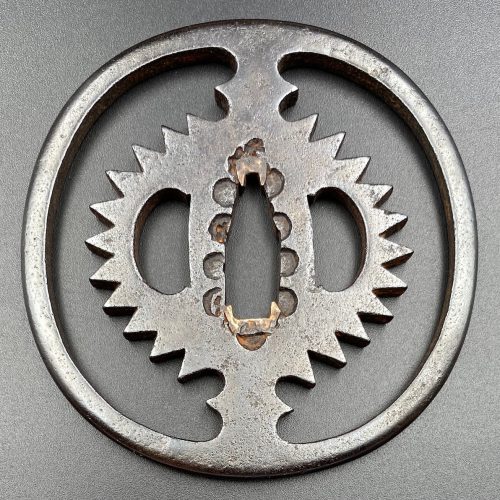 Iron tsuba of round form pierced with the design of slanting rays of light (Christian motif, Jesuit’s IHS symbol) in positive silhouette (ji-sukashi). This design is often called “tokei” [時計], or “clock gear”. Nakaga-ana fitted with copper sekigane. Rounded rim. Unsigned. Higo school. Early Edo period, mid-17th century (1632-1650).
Iron tsuba of round form pierced with the design of slanting rays of light (Christian motif, Jesuit’s IHS symbol) in positive silhouette (ji-sukashi). This design is often called “tokei” [時計], or “clock gear”. Nakaga-ana fitted with copper sekigane. Rounded rim. Unsigned. Higo school. Early Edo period, mid-17th century (1632-1650).Size: 78.3 x 77.0 x 5.3 mm
For information regarding this type of tsuba see the article 'Kirishitan Ikenie Tsuba by Fred Geyer at Kokusai Tosogu Kai; The 2nd International Convention & Exhibition, October 18-23, 2006, pp. 84-91. School and age attribution thanks to Bruce Kirkpatrick. . 
IHS emblem of the Jesuits
-
 Iron tsuba of a spindle shape (tate-itomaki-gata) pierced and inlaid in brass suemon-zōgan with bellflowers, vines and foliage, and a dragonfly in the upper right corner, on both sides. One of the hitsu-ana plugged with grey metal (led or pewter), nakaga-ana fitted with copper sekigane. The shape of the tsuba may be interpreted as four saddles connected to each other by horse bits. Such a design of sukashi and zōgan is usually attributed to Kaga Yoshirō branch of Heianjo school, active in the second half of the 17th century (c. 1650-1700). Size: 95.9 mm diagonal; 4.1 mm thickness. Tokubetsu Kicho certificate № 332 issued by NBTHK on October 12, 1965.
Iron tsuba of a spindle shape (tate-itomaki-gata) pierced and inlaid in brass suemon-zōgan with bellflowers, vines and foliage, and a dragonfly in the upper right corner, on both sides. One of the hitsu-ana plugged with grey metal (led or pewter), nakaga-ana fitted with copper sekigane. The shape of the tsuba may be interpreted as four saddles connected to each other by horse bits. Such a design of sukashi and zōgan is usually attributed to Kaga Yoshirō branch of Heianjo school, active in the second half of the 17th century (c. 1650-1700). Size: 95.9 mm diagonal; 4.1 mm thickness. Tokubetsu Kicho certificate № 332 issued by NBTHK on October 12, 1965. -
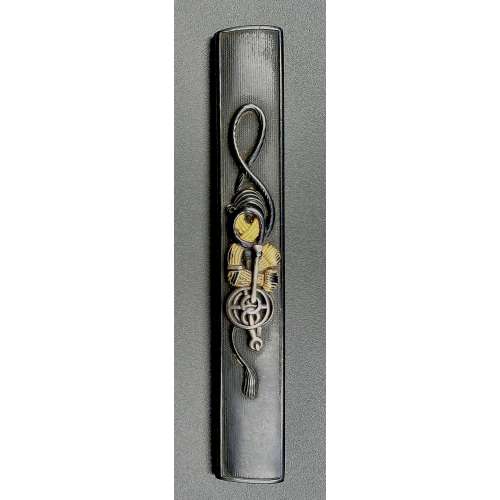 A shakudō kozuka decorated with equestrian tack inlaid in raven black shakudō, gold uttori and a silver alloy on a nanako ground. Unsigned. Attributed to Goto Joshin (Japanese, 1513 – 1562), 3rd generation Goto master. Late Muromachi period, Tenbun era (c. 1550). Size: 96.7 x 14.4 x 4.9 mm. Tokubetsu Hozon certificate № 2004230 issued by NBTHK on May 10, 2017. For a detailed explanation of terms see: Sesko, Markus. Handbook: Of Sword Fittings Related Terms. Germany: Books on Demand, 2011.
A shakudō kozuka decorated with equestrian tack inlaid in raven black shakudō, gold uttori and a silver alloy on a nanako ground. Unsigned. Attributed to Goto Joshin (Japanese, 1513 – 1562), 3rd generation Goto master. Late Muromachi period, Tenbun era (c. 1550). Size: 96.7 x 14.4 x 4.9 mm. Tokubetsu Hozon certificate № 2004230 issued by NBTHK on May 10, 2017. For a detailed explanation of terms see: Sesko, Markus. Handbook: Of Sword Fittings Related Terms. Germany: Books on Demand, 2011. -
 Iron tsuba of the round form (丸型, maru–gata), decorated with brass flat inlay (平象嵌, hira-zōgan) of bellflowers, leaves, and vines on both sides, inlaid brass is carved in low relief; wide rim (dote-mimi) also inlaid; the plate is pierced with hitsu-ana (probably original); nakago-ana plugged with copper sekigane. Dimensions: Height: 84.1 mm; Width: 82.0 mm; Thickness (centre): 2.8 mm; mimi is 11.8 mm wide and 4.7 mm thick. Produced at the end of the 16th century, in the Momoyama period (1674–1703).
Iron tsuba of the round form (丸型, maru–gata), decorated with brass flat inlay (平象嵌, hira-zōgan) of bellflowers, leaves, and vines on both sides, inlaid brass is carved in low relief; wide rim (dote-mimi) also inlaid; the plate is pierced with hitsu-ana (probably original); nakago-ana plugged with copper sekigane. Dimensions: Height: 84.1 mm; Width: 82.0 mm; Thickness (centre): 2.8 mm; mimi is 11.8 mm wide and 4.7 mm thick. Produced at the end of the 16th century, in the Momoyama period (1674–1703). -
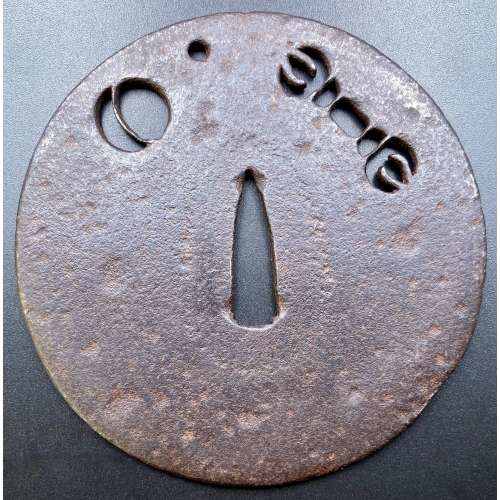 A ko-tosho tsuba made of iron, of the round form (丸型, maru-gata), pierced in negative silhouette (文透, mon-sukashi) with the design of Shingon Buddhism symbols of vajra [金剛杵] (kongosho), Sun, Moon and Star [月日星] (tsuki-hi-hoshi) – three sources of light [三光] (sankō). Round rim. No hitsu-ana; the shape of nakago-ana may suggest use on naginata [薙刀. Muromachi period (1393 – 1573). Height: 94.4 mm, Width: 93.4 mm, Centre thickness: 3.1 mm. Another possible explanation for "The element at the 11-o’clock position is in my opinion a kemari ball for the courtly game of the same name (picture attached)" [Markus Sesko].
A ko-tosho tsuba made of iron, of the round form (丸型, maru-gata), pierced in negative silhouette (文透, mon-sukashi) with the design of Shingon Buddhism symbols of vajra [金剛杵] (kongosho), Sun, Moon and Star [月日星] (tsuki-hi-hoshi) – three sources of light [三光] (sankō). Round rim. No hitsu-ana; the shape of nakago-ana may suggest use on naginata [薙刀. Muromachi period (1393 – 1573). Height: 94.4 mm, Width: 93.4 mm, Centre thickness: 3.1 mm. Another possible explanation for "The element at the 11-o’clock position is in my opinion a kemari ball for the courtly game of the same name (picture attached)" [Markus Sesko].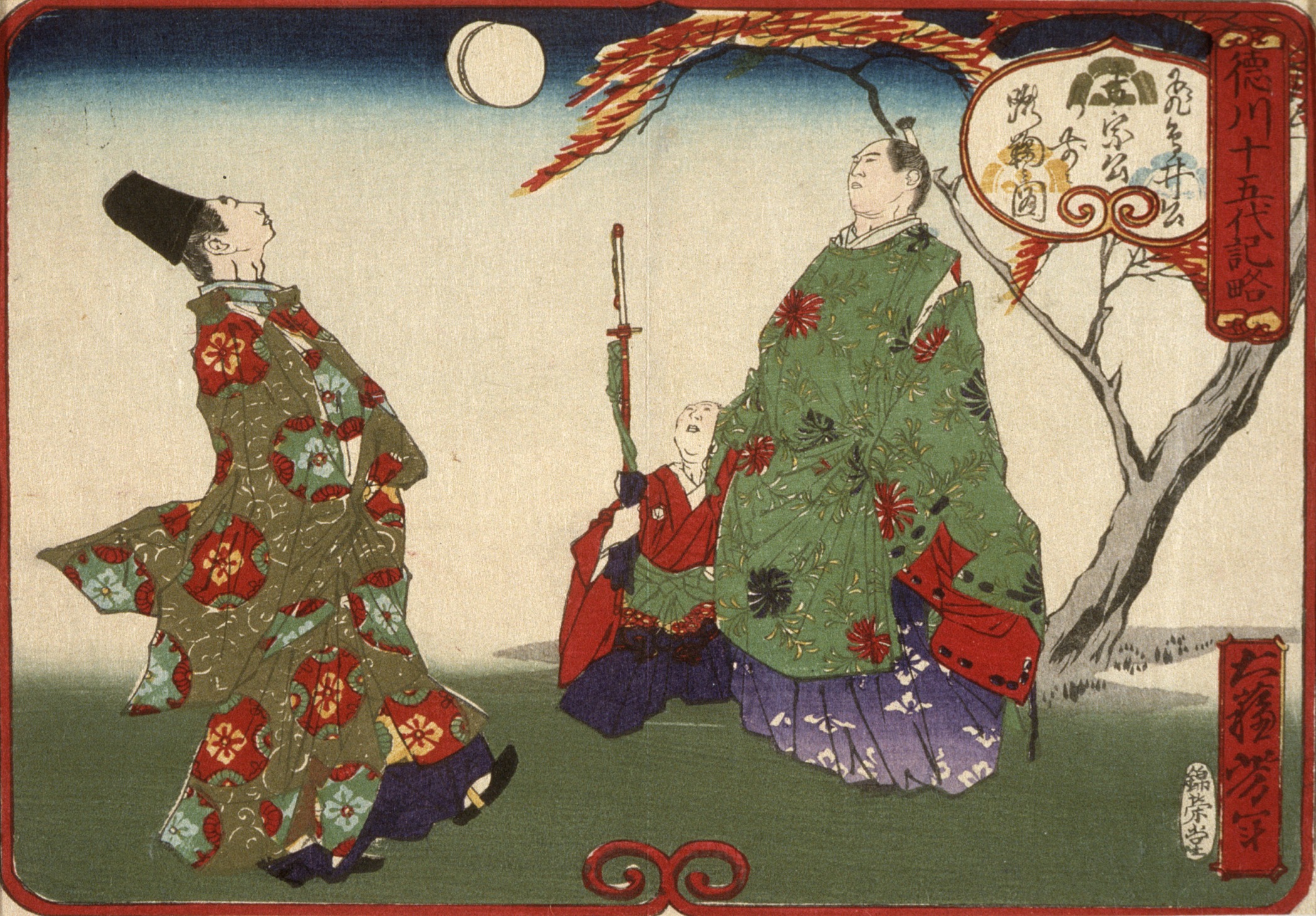
Tsukioka Yoshitoshi [月岡 芳年] (Japan, 1839 – 1892): Tokugawa Yoshimune [徳川 吉宗] (1684 – 1751) playing kemari [蹴鞠]




